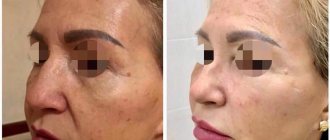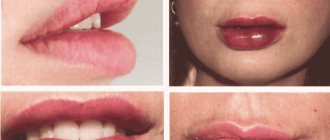- home
- Lipofilling
- Facial lipofilling in a clinic in Moscow
Facial lipofilling is a popular procedure for correcting appearance and rejuvenation. The uniqueness of lipofilling is that it is a volumetric method. The transplant replenishes age-related volume loss in certain areas, providing aesthetic correction of appearance and rejuvenation of surrounding tissues due to the high content of growth factors in adipocytes. The essence of the procedure is to transplant the patient’s fat tissue into the areas requiring correction.
The patient underwent complete facial lipofilling, with correction of the area of the lower eyelids, lips, nasolabial triangle and skin rejuvenation using the nanofat procedure.
Go to photo gallery
Benefits of lipofilling
— Lipofilling provides deep rejuvenation and correction of appearance. — Allows the use of the body’s own tissues, which completely eliminates the risk of allergic reactions or rejection. — Lipofilling is a minimally invasive and minimally traumatic procedure.
Correction zones
- Lips. Procedures to enlarge and reshape lips are now at the peak of popularity. However, correction with gels has to be repeated constantly, but lipofilling will only need to be done once. This is especially true if you do not want to increase the volume of your lips, but would not mind returning them to their former juiciness.
- Dark circles under the eyes. “Dips” and dark circles under the eyes are usually difficult to correct, but lipofilling easily copes with this task: in addition to replenishing volume, fat transfer leads to a noticeable improvement in the quality of the skin.
- Cheeks and cheekbones. The drooping of the tissues of the middle zone of the face leads to the appearance of jowls and deep nasolabial folds, blurring the contours of the lower jaw. To return a clear contour to the oval of the face, you will need to uniformly inject fat into the recessed areas.
Point injections smooth out nasolabial folds, nasolacrimal depressions, “dips” in the cheekbones and temples, create a gentle oval on thin, pointed faces, and improve the relief of the neck and décolleté. Lipofilling is absolutely indispensable for rejuvenating the hands when you need to smooth out protruding veins and tendons.
Benefits of lipofilling
The main advantage is that only the patient’s own fat cells are used for transplantation. And this eliminates the possibility of rejection, allergic reactions and other complications associated with the introduction of foreign products into the body. Other advantages of lipofilling include:
- lasting results after 1.5-2 months after complete engraftment of cells (according to statistics, 70-80% of transplanted tissues engraft forever);
- beautiful proportional contour;
- if desired and aesthetically necessary, the procedure can be repeated;
- Using the technique of transplanting your own fat cells, you can not only increase your shape, but also at the same time get rid of excess fat deposits in problem areas.
Lipofilling is often combined with plastic surgery. This combination allows you to get the most natural rejuvenation result. And if you want not only to restore volume to the tissues, but also to significantly improve the quality of the skin, you can combine the technology of lipofilling with nanolipofilling - in this case, the procedure will not only restore the visual attractiveness of the face, but will also have a powerful rejuvenating effect literally at the cellular level.
List of necessary tests
Procedures on certain areas of the face are performed under local anesthesia. So that the doctor can predict the result as accurately as possible and assess the condition of your body, you will need to undergo the following tests:
- general clinical blood test (complete + platelets);
- coagulogram (blood clotting time, bleeding time, INR, prothrombin index, fibrinogen, APTT);
- blood sugar (glucose) test;
- examinations for hepatitis B, hepatitis C, HIV, syphilis
*To assess the condition of the body and outline the optimal amount of correction, the doctor can individually prescribe an extended list of studies for you.
Rehabilitation period after lipofilling
Rehabilitation after facial liposculpture is very comfortable and short. It can be characterized by slight swelling and hematomas in the area of harvesting and implantation of adipose tissue for 6-8 days from the date of surgery. Final rehabilitation occurs after 4-6 weeks.
IMPORTANT!
- Lipofilling has virtually no contraindications; your own fat is not rejected by the body and does not cause allergies, which makes the lipofilling procedure not only effective, but also safe.
- The patient's adipose tissue is a real elixir of youth! Your own fat, restoring lost volumes, becomes an invaluable source of your own stem cells, which are of great importance for maintaining youthful skin.
- Lipofilling is perfectly combined with any surgical methods of facial rejuvenation, allowing you to achieve the most natural and long-term rejuvenating effect.
Contraindications to the procedure:
- chronic diseases in the acute stage;
- acute diseases of viral and infectious etiology;
- oncological diseases;
- diabetes mellitus type I and II, other endocrine disorders;
- connective tissue pathologies,
- disorders of the blood clotting system,
- lack of sufficient adipose tissue in the patient.
Please make an appointment for a medical consultation in advance and provide the doctor with truthful and as detailed information as possible about your medical condition. This will not only avoid possible complications, but will also increase the effectiveness of the procedure.
What percentage of fat survives after lipofilling?
Even 10 years ago, at plastic surgery conferences there were very active discussions about the percentage of fat engraftment: one part of the surgeons claimed that the engraftment rate was about 10-20%, the second - about 50%, the third - up to 70%. And each of them was actually right. The problem was that each doctor’s method of collecting and injecting fat was different.
Fat grafting seems to be a fairly simple plastic surgery at first glance, but in fact the fat transfer process has a lot of nuances, which subsequently affect the percentage of engrafted fat:
- Incorrect fat intake. If you introduce too much solution at the liposuction stage (which makes fat collection easier and bleeds less), then the percentage of fat cells per ml of the injected component will be much less, and accordingly the engraftment result will be worse.
- Using a centrifuge after fat collection. Nowadays, the use of a centrifuge is not recommended, since it separates fat cells (adipocytes) from stem cells, which end up at the bottom along with the solution and then merge, which also leads to a lower percentage of engraftment.
- After collecting the fat and placing it in a container, it is extremely important to stir it! If this is not done, the fat is divided into fractions and quickly, literally in 2 minutes it is already fragmented: at the top - oil, in the middle - fat cells, at the bottom - blood. For example, if a nurse who gives a ready-filled syringe to the doctor took one portion from the bottom, where there will be blood, and took the second portion from the middle, where there are a lot of fat cells, then naturally the result after administering the 1st portion will be almost unnoticeable.
- Bolus administration. If you inject fat with a thick cannula, as a bolus, you will get a large ball and naturally there will be a large percentage of fat cells that simply do not contact living tissue and therefore cannot take root. Fat needs to be injected in micro portions, and even with a thin cannula; this is very painstaking work. A thin millimeter cannula makes microchannels and with each pass we introduce no more than 1/20 of one cube. Imagine the difference of 1/20 of a cube or 10 cubes at once with a bolus injection. Doctors often sin with bolus injection, who perform several operations in one cut (for example, rhinoplasty + liposculpture) in order to save time. refilling the area under the eyes, cheeks and cheekbones
Lipofilling of nasolabial folds
Nasolabial folds that are too pronounced or very deep bring a lot of disappointment to their owners, however, this is an area that lends itself well to correction using both cosmetic and surgical methods.
Often, when asking the question about the need to correct the nasolabial fold, the patient implies the need to smooth it out by filling it.
It is believed that when correcting this zone, it is necessary to level the level of the fold itself to the level of the adjacent tissues. But you need to understand that the nasolabial fold is not always formed as a result of tissue creases and has its own natural depression. Sometimes its origin, on the contrary, is associated with overhanging tissue as a result of drooping subcutaneous fat, resulting in the formation of a so-called roller located just above the nasolabial fold and aggravating its depth and size.
With the help of lipofilling, you can achieve two goals simultaneously: remove fat accumulations from problem areas of the body and fill the areas that need volume with the resulting fat tissue. You can increase the volume of your breasts by receiving a thin waist as a gift, give a rounded and seductive shape to your buttocks, and eliminate the problem of curvature of your legs.
Insufficient volumes and imperfect proportions of the buttocks cause a lot of grief to their owners and serve as an object for constant improvement. There are 4 types of buttock shapes: A-shaped, V-shaped, round and square. For each of them, you can identify areas that require correction: the so-called “ears”, “dimples”, sagging areas, asymmetry, “smoothness”. The fat grafting technique, as lipofilling of the buttocks is also called, allows you to safely enlarge this part of the body and give it an ideal shape by introducing your own fat into the tissue. After analyzing all the nuances of the shape, plastic surgeons determine the correct tactics for fat transplantation. The result of the work is beautiful, proportionally developed, elastic and toned buttocks.
The volume and shape of the legs are determined by the thickness of the bones, muscle development, and the amount of fatty tissue. When determining the parameters of ideal legs, the “three windows” principle is used, when legs placed together should form 3 spindle-shaped defects: between the ankles and calves, between the calves and knees, between the knee joints and the upper third of the thigh. The shape of the legs is corrected through fat tissue transplantation - the introduction of prepared fat material into certain areas effectively eliminates the problem of curvature: deficiency of muscle and fat tissue in the perineal area; excessively thin, closed knee joints; obvious insufficiency of the soft tissue mass in the upper third of the leg and ankles.
Lipofilling can solve many problems with restoring the shape and volume of the breast. The procedure improves the appearance of breasts with noticeable asymmetry. To correct the shape of the mammary glands lost after pregnancy and lactation, fat injections are injected into the subcutaneous or intermuscular space without affecting the gland itself. By injecting adipose tissue, you can achieve breast enlargement by 0.5-1 size. For greater mammary gland enlargement, lipofilling is not only not recommended, but also dangerous, since after a certain period of time the transplanted fat cells can be distributed unevenly and even turn into unsightly scar tissue. To increase breast volume, a large amount of fat is required, which gradually takes root. The growth of blood vessels and capillaries into it requires a certain time, and its own tissue cannot function for a long time without appropriate nutrition. When enlarging the mammary glands with implants, the lipofilling technique is used to hide the edges of the artificial material. Very often lipofilling is used in the case of reduction mammoplasty.
How long does it take for the fat to take root and when can you see the final result?
Engrafted fat is already present a month after lipofilling. But there are some fat cells that have not yet taken root as well. The entire metabolic process of engraftment and utilization of destroyed fat ends by 6 months and then we can see the final result. As for facial lipofilling, the result can be seen even earlier, because there is a good blood supply and small volumes of injection, and buttock lipofilling - no earlier than 6 months. From my experience, on average, 50% fat survives, so during lipofilling, you need to deliberately introduce excess fat, more than necessary, given that the volume of fat will decrease.
To prove the effectiveness of lipofilling, I can say that in Brazil and Colombia this is operation No. 1. Patients (often at a young age, so there is no sagging skin) have fat taken from the waist in a circle and injected into the buttocks on average 1-1, 5 liters each. And after 2-3-4 years, no one says that the buttocks have become much smaller. If fat had not taken root so massively, this technique would have been abandoned long ago. But there are also dissatisfied patients, to whom the fat was injected either poorly, or, on the contrary, it was too much (when a lot of it was injected), these are the 2 main problems of lipofilling.









